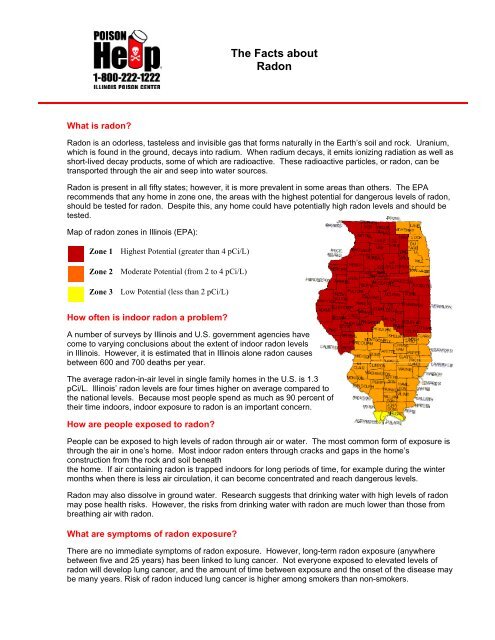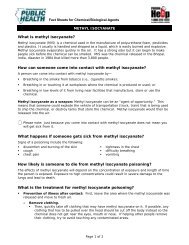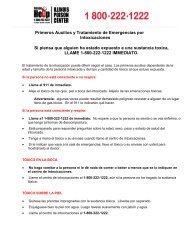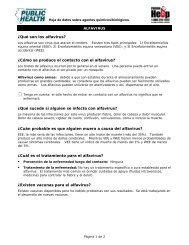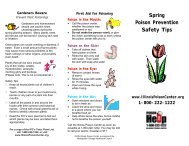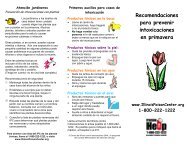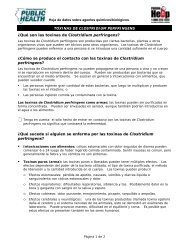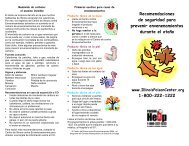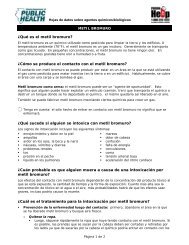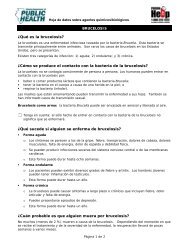Fact sheet - Illinois Poison Center
Fact sheet - Illinois Poison Center
Fact sheet - Illinois Poison Center
You also want an ePaper? Increase the reach of your titles
YUMPU automatically turns print PDFs into web optimized ePapers that Google loves.
The <strong>Fact</strong>s aboutRadonWhat is radon?Radon is an odorless, tasteless and invisible gas that forms naturally in the Earth’s soil and rock. Uranium,which is found in the ground, decays into radium. When radium decays, it emits ionizing radiation as well asshort-lived decay products, some of which are radioactive. These radioactive particles, or radon, can betransported through the air and seep into water sources.Radon is present in all fifty states; however, it is more prevalent in some areas than others. The EPArecommends that any home in zone one, the areas with the highest potential for dangerous levels of radon,should be tested for radon. Despite this, any home could have potentially high radon levels and should betested.Map of radon zones in <strong>Illinois</strong> (EPA):Zone 1 Highest Potential (greater than 4 pCi/L)Zone 2 Moderate Potential (from 2 to 4 pCi/L)Zone 3 Low Potential (less than 2 pCi/L)How often is indoor radon a problem?A number of surveys by <strong>Illinois</strong> and U.S. government agencies havecome to varying conclusions about the extent of indoor radon levelsin <strong>Illinois</strong>. However, it is estimated that in <strong>Illinois</strong> alone radon causesbetween 600 and 700 deaths per year.The average radon-in-air level in single family homes in the U.S. is 1.3pCi/L. <strong>Illinois</strong>’ radon levels are four times higher on average compared tothe national levels. Because most people spend as much as 90 percent oftheir time indoors, indoor exposure to radon is an important concern.How are people exposed to radon?People can be exposed to high levels of radon through air or water. The most common form of exposure isthrough the air in one’s home. Most indoor radon enters through cracks and gaps in the home’sconstruction from the rock and soil beneaththe home. If air containing radon is trapped indoors for long periods of time, for example during the wintermonths when there is less air circulation, it can become concentrated and reach dangerous levels.Radon may also dissolve in ground water. Research suggests that drinking water with high levels of radonmay pose health risks. However, the risks from drinking water with radon are much lower than those frombreathing air with radon.What are symptoms of radon exposure?There are no immediate symptoms of radon exposure. However, long-term radon exposure (anywherebetween five and 25 years) has been linked to lung cancer. Not everyone exposed to elevated levels ofradon will develop lung cancer, and the amount of time between exposure and the onset of the disease maybe many years. Risk of radon induced lung cancer is higher among smokers than non-smokers.
Long-term radon exposure through drinking water has been linked to stomach cancer.A National Academy of Sciences report concluded that drinking radon in water causes about 19 stomachcancer deaths per year.There is no conclusive data concerning whether or not children are more at risk, if exposed to high levels ofradon, than adults.What can I do to make sure I am not exposed toradon?Radon levels can vary from neighborhood to neighborhoodand home to home. The only way to tell how muchradon is present in your home is to conduct aradon test. Radon test kits can be purchasedfrom hardware stores and local agencies and cancost anywhere between $5 and $25. Radonmeasurement professionals may conduct testingfor a cost of $100 to $150. A list of registeredmeasurement professions can be found atwww.state.il.us/iema/radon/radon.htm.What is a normal level of radon?The Environmental Protection Agency (EPA)considers four or more picocuries per liter of airSource: http://geoscape.nrcan.gc.ca/ottawa/radon_e.php`(pCi/L) or working levels units (WL) to be anelevated radon level. If the radon level in your home is at this level or above, the EPA recommends that itbe fixed.How can I get radon out of my home?In order to rid your home of radon, you must contact a licensed professional to mitigate your home, or alter itfor the purpose of reducing the concentration of radon in the indoor environment.The average cost of a mitigation system is $800 to $1200.To find a list of licensed radon mitigationprofessionals in your county please visit: http://www.state.il.us/idns/html/radon/lists/mitigation.aspHow can I get radon out of my drinking water?Radon can be eliminated from drinking water through two types of water treatment—aeration devices andgranular activated carbon (GAC) filters. Aeration devices spray water or mix it with air, and then vent the airfrom the water to remove the radon. GAC filters use activated carbon to remove radon in the form of gas.GAC filters tend to cost less than aeration devices; however, GAC filters may require special disposalmethods.Where can I get more information?<strong>Illinois</strong> Environmental Protection Agency: http://www.epa.state.il.us/U.S. Environmental Protection Agency (EPA): http://www.epa.gov/National Safety Council: http://www.nsc.org/<strong>Illinois</strong> Emergency Management Agency: www.state.il.us/iema/radon/radon.htm or call 1-800-325-1245


